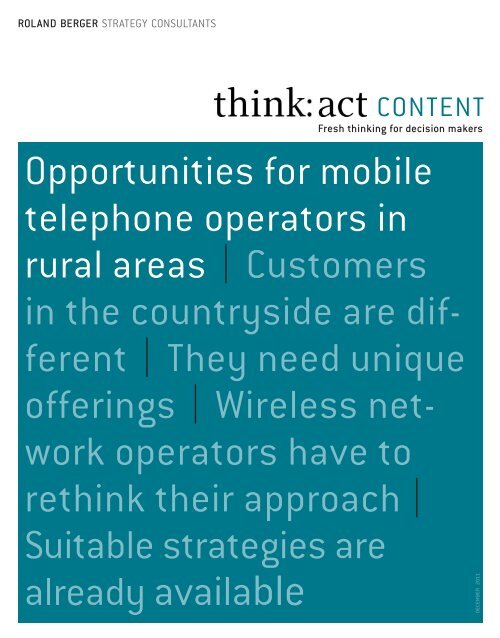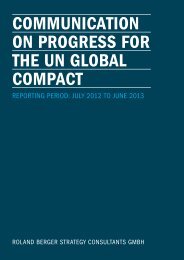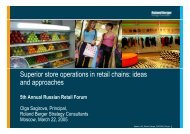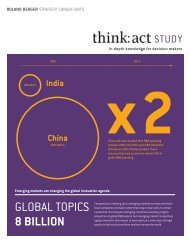opportunities for mobile telephone operators in rural areas ...
opportunities for mobile telephone operators in rural areas ...
opportunities for mobile telephone operators in rural areas ...
You also want an ePaper? Increase the reach of your titles
YUMPU automatically turns print PDFs into web optimized ePapers that Google loves.
Roland Berger Strategy Consultants<br />
content<br />
Fresh th<strong>in</strong>k<strong>in</strong>g <strong>for</strong> decision makers<br />
Opportunities <strong>for</strong> <strong>mobile</strong><br />
<strong>telephone</strong> <strong>operators</strong> <strong>in</strong><br />
<strong>rural</strong> <strong>areas</strong> | Customers<br />
<strong>in</strong> the countryside are different<br />
| They need unique<br />
offer<strong>in</strong>gs | Wireless network<br />
<strong>operators</strong> have to<br />
reth<strong>in</strong>k their approach |<br />
Suitable strategies are<br />
already available<br />
December 2011
SuCCESS IN RuRal MaRKETS:<br />
NEW CuSTOMERS FOR<br />
TElECOMMuNICaTION BuSINESSES<br />
Large population <strong>in</strong> <strong>rural</strong> <strong>areas</strong> * :<br />
India ≈ 800 m<br />
Ch<strong>in</strong>a ≈ 865 m<br />
-<br />
Net subscriber additions <strong>in</strong><br />
<strong>rural</strong> <strong>areas</strong> 2007-2010 * :<br />
India ≈ 107 m<br />
Ch<strong>in</strong>a ≈ 128 m<br />
x<br />
Desire <strong>for</strong><br />
<strong>mobile</strong><br />
phones:<br />
90%<br />
=<br />
Potential customers:<br />
≈ 1.29 bn<br />
* examples
content Rural Markets<br />
Sometime <strong>in</strong> the mid-1980s, the first <strong>mobile</strong> phones appeared <strong>in</strong> Hollywood films, as a status<br />
symbol <strong>for</strong> the rich and powerful. Gone are those days. Today <strong>mobile</strong> communication is so<br />
commonplace that the markets of the <strong>in</strong>dustrialized world are thought to have reached<br />
saturation po<strong>in</strong>t. Mobility players f<strong>in</strong>d it hard to achieve even meager growth rates <strong>in</strong> these<br />
markets. Th<strong>in</strong>gs look totally different <strong>in</strong> emerg<strong>in</strong>g and develop<strong>in</strong>g countries, where <strong>mobile</strong><br />
phones are less widespread.<br />
But this is chang<strong>in</strong>g fast. The demand <strong>for</strong> <strong>mobile</strong> communication <strong>in</strong> these countries is high, as<br />
the growth rates <strong>in</strong> several key emerg<strong>in</strong>g markets show (Egypt, Brazil, Ch<strong>in</strong>a, India, Indonesia,<br />
Nigeria, Pakistan and Thailand). Here, 570 million new <strong>mobile</strong> phone subscribers were added<br />
between 2007 and 2010. However, these new customers are not all city dwellers, as you might<br />
th<strong>in</strong>k. There is considerable demand <strong>for</strong> <strong>mobile</strong> communication among the <strong>rural</strong> population<br />
too. Most of the 570 million new customers, 303 million to be exact, live <strong>in</strong> <strong>rural</strong> <strong>areas</strong>. And the<br />
growth cont<strong>in</strong>ues: Well over 90% of those currently without a <strong>mobile</strong> phone want one.<br />
"Metropolitan" bus<strong>in</strong>ess models do not work <strong>in</strong> the countryside<br />
Un<strong>for</strong>tunately, this demand does not automatically translate <strong>in</strong>to big profits. Product design,<br />
sales and market<strong>in</strong>g models established <strong>in</strong> the cities cannot simply be transferred to the<br />
countryside. Equipp<strong>in</strong>g sparsely populated <strong>areas</strong> with the technical <strong>in</strong>frastructure needed <strong>for</strong><br />
comprehensive <strong>mobile</strong> coverage does not come cheap: <strong>in</strong> fact, the costs <strong>in</strong>crease as one penetrates<br />
more remote markets. At the same time, s<strong>in</strong>ce the <strong>rural</strong> population has a low average<br />
<strong>in</strong>come, the Average Revenue Per User (ARPU) tends to reduce with remoteness.<br />
On a hayride<br />
PROFIT Rural<br />
PROFIT City<br />
Mobile <strong>telephone</strong> <strong>operators</strong> should also take the path<br />
to the countryside if they look out <strong>for</strong> new customers.<br />
In the long run, ignor<strong>in</strong>g the <strong>rural</strong> population's need <strong>for</strong> <strong>mobile</strong> communication <strong>for</strong> the above<br />
reasons is not a good idea. It would leave the field wide open to competitors. And s<strong>in</strong>ce customer<br />
growth <strong>in</strong> <strong>rural</strong> <strong>areas</strong> is at least as fast as that <strong>in</strong> urban <strong>areas</strong>, significant market share<br />
would be lost. Relatively low ARPU among new customers can be compensated <strong>for</strong> by high<br />
volumes. Not to mention the additional image boost.<br />
Among companies who have entered the <strong>rural</strong> market, the successful ones are those who see<br />
their <strong>rural</strong> customers as a separate customer group that has to be addressed with specially<br />
tailored concepts. Companies who simply transfer the concepts they have established <strong>in</strong> big<br />
cities to the countryside, are dest<strong>in</strong>ed to fail.<br />
Tak<strong>in</strong>g the network to the countryside<br />
Expand<strong>in</strong>g a network <strong>in</strong> <strong>rural</strong> regions us<strong>in</strong>g urban quality yardsticks <strong>for</strong> network coverage and<br />
speech quality is expensive and complicated. A strategy of expand<strong>in</strong>g cheaply and quickly with<br />
moderate quality of network coverage is more promis<strong>in</strong>g. This may reduce quality, but quality<br />
can be improved once there are enough customers spend<strong>in</strong>g enough money. The opposite<br />
strategy of a high-quality but slow and expensive network expansion not only reduces f<strong>in</strong>ancial
Roland Berger Strategy Consultants<br />
capacity <strong>for</strong> other <strong>in</strong>vestments but leaves a company vulnerable to faster competitors. Collaborative<br />
approaches at an <strong>in</strong>dustry-level or with governmental support are also be<strong>in</strong>g explored,<br />
especially <strong>in</strong> African countries.<br />
Tailor<strong>in</strong>g the product to <strong>rural</strong> customer segments<br />
It is also important to face the fact that not all <strong>rural</strong> consumers are the same. Farmers,<br />
students, <strong>rural</strong> workers or <strong>rural</strong> bus<strong>in</strong>ess owners have, <strong>for</strong> example, different <strong>in</strong>come levels,<br />
<strong>in</strong>ternet usage, and different communications habits and needs. One product does not fit all.<br />
Companies have to understand that <strong>rural</strong> customers need to be segmented and their value<br />
proposition drivers understood. This consumer <strong>in</strong>sight should be used to design tailored products<br />
and services <strong>for</strong> <strong>rural</strong> consumers.<br />
Small is beautiful<br />
MAKE<br />
IT<br />
SMALL<br />
To offer <strong>rural</strong> customers smaller packages proved to<br />
be a successful bus<strong>in</strong>ess model, as other companies<br />
found out.<br />
Af<strong>for</strong>dability is key ...<br />
In general, the average <strong>in</strong>come of <strong>rural</strong> customer target groups is much lower than <strong>in</strong> big cities.<br />
Differences of a few cents can mean a lot to them – af<strong>for</strong>dability is essential. Other <strong>in</strong>dustries<br />
can provide ideas <strong>for</strong> new approaches. Food corporation Nestlé, <strong>for</strong> example, reduced the size<br />
of coffee and milk powder packages and sold them at a lower price – successfully, as the sales<br />
figures show. Nestlé's Bono cookies are an excellent example: The packet size was reduced<br />
from 200 to 140 grams, and sales rose 40% as a result. Consumer products giant Procter &<br />
Gamble had a similar experience when it reduced the size of toothpaste tubes and detergent<br />
sachets.<br />
Cav<strong>in</strong>Kare, a producer of beauty and personal care products, took a slightly different route. The<br />
company identified how much local customers <strong>in</strong> India would be will<strong>in</strong>g to pay <strong>for</strong> shampoo –<br />
and created the appropriate package size. It paid off: The company ga<strong>in</strong>ed a 40% market share.<br />
Tak<strong>in</strong>g a page from this playbook, an Asian <strong>mobile</strong> phone provider applied this model: It modified<br />
its pay-as-you-go contract to allow users a m<strong>in</strong>imum balance of just USD 5 cents – with<br />
great success.<br />
All these examples follow the same idea: Successful companies often reduce entry barriers <strong>for</strong><br />
their ma<strong>in</strong> target group by tailor<strong>in</strong>g the product to the pocket of the customer. This helps the<br />
product to penetrate the market and built a customer habit, which could lead to last<strong>in</strong>g loyalty<br />
over time.<br />
... but value-adds are still possible<br />
Besides the very price-sensitive target group, the <strong>rural</strong> population also consists of segments<br />
who aren't conv<strong>in</strong>ced by cheapest offers alone. Here, another strategy could be promis<strong>in</strong>g: To<br />
l<strong>in</strong>k the core product – <strong>in</strong> our case, country dwellers' desire <strong>for</strong> <strong>mobile</strong> communication – with<br />
other services relevant to the target group. Ch<strong>in</strong>a Mobile, <strong>for</strong> example, developed an offer<strong>in</strong>g<br />
<strong>for</strong> the target group of farmers that provides a subscription to farm<strong>in</strong>g-related <strong>in</strong><strong>for</strong>mation on<br />
prices and price trends <strong>in</strong> addition to their <strong>mobile</strong> phone contract.<br />
Us<strong>in</strong>g this and similar other value-added approaches, Ch<strong>in</strong>a Mobile ga<strong>in</strong>ed nearly 13% new<br />
customers <strong>in</strong> 2010, total<strong>in</strong>g to 523 million users. Revenue from value-added bus<strong>in</strong>ess reached<br />
RMB 151.4 billion (USD 63.6 billion), represent<strong>in</strong>g an annual growth rate of more than 15% and<br />
account<strong>in</strong>g <strong>for</strong> roughly 31% of Ch<strong>in</strong>a Mobile Group's operat<strong>in</strong>g venue. Ch<strong>in</strong>a Mobile uses a cen-
content Rural Markets<br />
tral plat<strong>for</strong>m, but localized the operation <strong>in</strong> deliver<strong>in</strong>g content on a prov<strong>in</strong>ce or region basis. The<br />
key of success also lies <strong>in</strong> cooperation, e.g. the company <strong>for</strong>med a relationship with <strong>in</strong>dividual<br />
specialists like a card manufacturer, who created a menu embedded card.<br />
Other add-on services are possible, <strong>in</strong> the realm of healthcare, <strong>for</strong> example: In emerg<strong>in</strong>g and<br />
develop<strong>in</strong>g countries there is a lack of all-around healthcare provision <strong>for</strong> most of the <strong>rural</strong><br />
population. The next medical service station is often far away. At the same time, many widespread<br />
diseases such as tuberculosis or HIV require regular care and <strong>in</strong>tensive monitor<strong>in</strong>g<br />
by medical professionals. A good use of <strong>mobile</strong> phone technology would be to query certa<strong>in</strong><br />
key parameters with the patient and transmit them digitally to the doctor <strong>in</strong> charge. With this,<br />
specialist advice is possible even at remote <strong>rural</strong> cl<strong>in</strong>ics and non-frequent visits to the doctor<br />
can be compensated partially at least.<br />
Access granted<br />
554<br />
m<br />
539<br />
m<br />
522<br />
m<br />
570<br />
m<br />
584<br />
m<br />
Another promis<strong>in</strong>g value-added area <strong>for</strong> <strong>mobile</strong> <strong>operators</strong> is <strong>mobile</strong> bank<strong>in</strong>g. In sub-Saharan<br />
Africa, <strong>for</strong> example, over 470 million people earn less than the equivalent of USD 10 a day – but<br />
together, they would be able to deposit almost EUR 60 billion annually, yet only one <strong>in</strong> five has<br />
a bank account at all. By contrast, even the lowest earners <strong>in</strong> Africa usually have a <strong>mobile</strong> phone.<br />
In other emerg<strong>in</strong>g and develop<strong>in</strong>g countries there is a similar situation: In India, a Roland Berger<br />
case study found that 230 million cellphone users currently make little or no use of bank<strong>in</strong>g services.<br />
This number is likely to <strong>in</strong>crease <strong>in</strong> the years ahead s<strong>in</strong>ce the population is grow<strong>in</strong>g faster<br />
than the banks' new customer bus<strong>in</strong>ess. So why not leverage the appeal of <strong>mobile</strong> telephony to<br />
l<strong>in</strong>k bank<strong>in</strong>g services and <strong>mobile</strong> communication Of course, the banks would benefit from such<br />
a scheme, but so would <strong>mobile</strong> phone companies. They could stand out from their competitors<br />
by offer<strong>in</strong>g these value-added services and expand their customer base. Several banks already<br />
started to tie up with the telecom-companies to roll out their bus<strong>in</strong>esses <strong>in</strong> <strong>rural</strong> <strong>areas</strong>.<br />
Reach<strong>in</strong>g out to remote customers – economically<br />
Alongside network expansion and product design, the right sales setup is crucial <strong>for</strong> successfully<br />
w<strong>in</strong>n<strong>in</strong>g new customers <strong>in</strong> the countryside. Revenues at <strong>rural</strong> po<strong>in</strong>ts of sale tend to be a<br />
lot lower than <strong>in</strong> cities, with comparatively high cost to serve the channels. The traditional topdown<br />
sales hierarchy of one national distributor, several regional distributors and local retailers<br />
does not always work <strong>in</strong> the <strong>rural</strong> <strong>areas</strong>.<br />
4 Q<br />
2009<br />
1 Q<br />
2010<br />
2 Q<br />
2010<br />
Ch<strong>in</strong>a Mobile's subscription uptake has <strong>in</strong>creased<br />
steadily quarter after quarter, after provid<strong>in</strong>g<br />
af<strong>for</strong>dable value-added services to <strong>rural</strong> users.<br />
Further <strong>in</strong><strong>for</strong>mation<br />
3 Q<br />
2010<br />
4 Q<br />
2010<br />
One successful strategy is to set up <strong>rural</strong> distributors alongside the regional urban distributors,<br />
with shared costs and <strong>in</strong>frastructure. These <strong>rural</strong> distributors know the local market well<br />
and can handle it via micro-distributors, which are either small town retailers or semi-urban/<br />
<strong>rural</strong> retailers. Many companies shy away from this approach because they fear reduced visibility<br />
and control <strong>in</strong> the supply cha<strong>in</strong>, and also dim<strong>in</strong>ished ability to "push" material <strong>in</strong>to cha<strong>in</strong>.<br />
However, these challenges can be addressed with an active sales management approach.<br />
Follow<strong>in</strong>g this idea consequently results <strong>in</strong> down-to-earth solutions conv<strong>in</strong>c<strong>in</strong>g by their simplicity:<br />
Stockists <strong>in</strong> <strong>rural</strong> <strong>areas</strong> can use cycles and even boats <strong>for</strong> their distribution and there<strong>for</strong>e<br />
overcome <strong>in</strong>frastructural contra<strong>in</strong>ts – and by do<strong>in</strong>g so, reach customers <strong>in</strong> remote <strong>areas</strong> or<br />
t<strong>in</strong>y settlements, <strong>for</strong> which even a distribution via sub-trucks or vans would be too elaborate.<br />
Altogether, a cheap and quick-to-establish way to service new customers <strong>in</strong> <strong>rural</strong> <strong>areas</strong>. On the<br />
Roland Berger Strategy Consultants has developed<br />
strategies <strong>for</strong> the bank<strong>in</strong>g sector <strong>in</strong> sub-Saharan<br />
Africa.
Roland Berger Strategy Consultants<br />
downside, these solutions are not scalable, as there is no network of consolidated service<br />
providers.<br />
Expand<strong>in</strong>g exist<strong>in</strong>g sales partnerships or establish<strong>in</strong>g new cooperations with bigger companies<br />
is faster and less capital-<strong>in</strong>tensive. F<strong>in</strong>ally, there is the possibility to use exist<strong>in</strong>g mass<br />
distribution systems like PDS and post services. The advantage lies with<strong>in</strong> its great reach and<br />
its established, trusted channel. But it comes at the expense of less control over a standardized<br />
brand image and sometimes <strong>in</strong>ertia toward the distribution of new products – and is thus more<br />
suitable <strong>for</strong> regions with lower customer potential.<br />
Spread the product<br />
Companies who are successful <strong>in</strong> <strong>rural</strong> <strong>areas</strong> use<br />
different distribution channels – as long as these are<br />
cheap and quick to establish.<br />
Consumer goods-companies leveraged <strong>in</strong>novative partnerships to drive distribution reach and<br />
fundamentally alter distribution economics. Some of them outsourced last mile distribution<br />
by tra<strong>in</strong><strong>in</strong>g key <strong>in</strong>fluencers from each neighborhood <strong>in</strong> <strong>areas</strong> where conventional distribution<br />
networks can not economically reach.<br />
Expla<strong>in</strong><strong>in</strong>g the value added<br />
A small-scale but focused sales approach also helps companies demonstrate to potential<br />
customers the value added of their products. Nokia, <strong>for</strong> example, deploys "sales<strong>mobile</strong>s" <strong>in</strong><br />
emerg<strong>in</strong>g and develop<strong>in</strong>g countries – small vans <strong>in</strong> which sales reps tour the country promot<strong>in</strong>g<br />
the latest services and add-on offer<strong>in</strong>gs <strong>for</strong> the "farmers of today". The Korean white goods<br />
manufacturer LG takes a similar approach to expla<strong>in</strong> its microwave product group, <strong>in</strong>clud<strong>in</strong>g<br />
cook<strong>in</strong>g demonstrations <strong>in</strong> a small van. And Unilever's Shakti program <strong>in</strong> India collaborates<br />
with local female entrepreneurs who advise their clientele on health and hygiene matters as<br />
well as sell<strong>in</strong>g them the appropriate products. Local sales representatives are able to elim<strong>in</strong>ate<br />
suspicion, answer questions and demonstrate the product live – benefits that not every store<br />
can offer. This small-scale channel means that <strong>rural</strong> sales will never be as cheap as <strong>in</strong> cities. But<br />
<strong>in</strong>volvement specially tailored to the region and target group can certa<strong>in</strong>ly be worthwhile, as it<br />
also boosts the brand.<br />
Consumer Education <strong>in</strong> general helps to grow bus<strong>in</strong>ess. To expla<strong>in</strong> the benefits of cellular mobility<br />
to non-users reaches out to new potential. F<strong>in</strong>ally, technology gives <strong>mobile</strong> <strong>operators</strong> <strong>opportunities</strong><br />
to create <strong>in</strong>expensive sale models, <strong>for</strong> example by launch<strong>in</strong>g e-recharge systems to top<br />
up credit on a pay-as-you-go phone – but this technology of course also needs to be expla<strong>in</strong>ed.
content Rural Markets<br />
Good th<strong>in</strong>gs come <strong>in</strong> threes<br />
Success factors <strong>for</strong> <strong>rural</strong> bus<strong>in</strong>ess<br />
The right way <strong>for</strong> a <strong>mobile</strong> operator to do bus<strong>in</strong>ess <strong>in</strong> <strong>rural</strong> <strong>areas</strong> depends partly on which<br />
target groups have the most customer potential, which markets competitors already occupy<br />
and which sales <strong>for</strong>mats can be used. Roland Berger has identified three key factors<br />
based on its experience from various customer projects:<br />
1. Product design: The product must be tailored to the target group's needs, whether <strong>in</strong><br />
terms of entry-level prices or regular costs. The product could also be made more appeal<strong>in</strong>g<br />
through add-on services (e.g. <strong>mobile</strong> bank<strong>in</strong>g). Simply transferr<strong>in</strong>g popular metropolitan<br />
products to the countryside will not work.<br />
2. Sales and distribution: Rural sales activities need to be organized on a smaller scale<br />
and with more focus. Only then can they meet the <strong>rural</strong> population's needs and expectations.<br />
In some cases, partnerships may play a key role, possibly <strong>in</strong>volv<strong>in</strong>g a loss of control<br />
which needs to be managed. Partnerships can also be used to leverage scale and<br />
expand reach. Innovations <strong>in</strong> distribution models will fundamentally reduce cost and<br />
improve effectiveness.<br />
Brand and market<strong>in</strong>g<br />
Product design<br />
Sales and distribution<br />
Roland Berger Strategy Consultants identified three<br />
key factors <strong>for</strong> success <strong>in</strong> <strong>rural</strong> markets.<br />
3. Brand and market<strong>in</strong>g: Only if the benefits of the offer<strong>in</strong>g and possible add-on services<br />
are clear will <strong>rural</strong> customers be won over. Rural customers value the experience of local<br />
contact people such as their local shopkeeper. It is essential to th<strong>in</strong>k beyond the traditional<br />
and use non-traditional and local media effectively.<br />
For <strong>mobile</strong> <strong>operators</strong>, it's about more than only growth beyond the metropolitan <strong>areas</strong>. The<br />
enlargement of customer base also strengthens the company as a whole – and there<strong>for</strong>e<br />
also <strong>in</strong> the cities. The <strong>in</strong>troduction of new distribution models enhances know-how with<strong>in</strong><br />
the company. And new collaboration models could also prove as valuable <strong>for</strong> the bus<strong>in</strong>ess<br />
<strong>in</strong> metropolitan <strong>areas</strong>. To master the above mentioned challenges there<strong>for</strong>e are a task <strong>for</strong><br />
all market participants.<br />
IF YOU HAVE ANY QUESTIONS, PLEASE FEEL<br />
FREE TO CONTACT US:<br />
Chandan Joshi, Partner<br />
+65 6622 – 5480<br />
chandan.joshi@rolandberger.com<br />
Thomas Klotz, Partner<br />
+65 6622 – 5478<br />
thomas_klotz@sg.rolandberger.com<br />
th<strong>in</strong>k:act CONTENT<br />
Publisher:<br />
Prof. Dr. Burkhard Schwenker, Dr. Mart<strong>in</strong> C. Wittig<br />
Project management: Dr. Kather<strong>in</strong>e Nöll<strong>in</strong>g<br />
Roland Berger Strategy Consultants GmbH<br />
Am Sandtorkai 41<br />
20457 Hamburg<br />
+49 40 37631 – 4421<br />
news@rolandberger.com<br />
www.th<strong>in</strong>k-act.<strong>in</strong>fo
Would you like to get your copy of<br />
th<strong>in</strong>k:act CONT…NT faster<br />
Send your e-mail address to us at<br />
global_market<strong>in</strong>g@de.rolandberger.com<br />
and you will receive the next issue<br />
<strong>in</strong> advance!
















